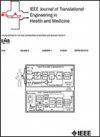ECG-Mamba: Cardiac Abnormality Classification With Non-Uniform-Mix Augmentation on 12-Lead ECGs
IF 4.4
3区 医学
Q2 ENGINEERING, BIOMEDICAL
IEEE Journal of Translational Engineering in Health and Medicine-Jtehm
Pub Date : 2025-09-23
DOI:10.1109/JTEHM.2025.3613609
引用次数: 0
Abstract
Objective: The detection of heart abnormalities using electrocardiograms (ECG) is a critical task in medical diagnostics. A lot of literature has utilized ResNet and Transformer architectures to detect heart disease based on ECG signals. Recently, a new class of algorithms has emerged, challenging these established methods. A selective state space model (SSM) called Mamba has exhibited promising potential as an alternative to Transformers due to its efficient handling of longer sequences. In this context, we propose a Mamba-based model for detecting heart abnormalities, named ECG-Mamba. Recognizing that common data augmentation methods such as MixUp and CutMix do not perform well with Mamba on ECG data, we introduce a data augmentation technique called non-uniform-mix to enhance the model’s performance.Methods and procedures: ECG-Mamba is based on Vision Mamba (Vim), a variant of Mamba that utilizes a bidirectional SSM, enhancing its capability to process ECG data effectively. To address the sensitivity of the Mamba model to noise and the lack of suitable data augmentation techniques, we propose a data augmentation algorithm that conservatively introduces data augmentation by performing non-uniform operations on the dataset across different epochs. Specifically, we apply MixUp to a portion of the dataset in different epochs.Results: Experimental results indicate that ECG-Mamba outperforms the best algorithms in the PhysioNet/Computing in Cardiology (CinC) Challenges of 2020 and 2021 based on the AUPRC and AUROC, specifically with ECG-Mamba achieving an AUPRC score 16.6% higher than the best algorithm in the PhysioNet/CinC Challenge 2021 on 12-lead ECGs, reaching 0.61. Moreover, with the proposed data augmentation method Non-Uniform-Mix, ECG-Mamba’s AUPRC reached 0.6271, representing a 2.8% improvement.Conclusion: The ECG-Mamba model, based on the SSM, demonstrates potential in detecting cardiac abnormalities from ECG data. Although the model surpasses existing algorithms, it exhibits sensitivity to noise, requiring careful data augmentation. The proposed conservative data augmentation technique addresses this challenge and improves the model’s performance, suggesting a promising direction for future research in ECG analysis using SSMs. The implementation is publicly available at心电图曼巴:心脏异常分类与非均匀混合增强的12导联心电图
目的:利用心电图检测心脏异常是医学诊断中的一项重要任务。许多文献利用ResNet和Transformer架构来检测基于心电信号的心脏病。最近,一类新的算法出现了,挑战这些既定的方法。选择性状态空间模型(SSM)称为曼巴已经显示出有希望的潜力,作为替代变形金刚由于其有效的处理较长的序列。在这种情况下,我们提出了一种基于曼巴的检测心脏异常的模型,称为ecg -曼巴。认识到常见的数据增强方法如MixUp和CutMix在曼巴心电图数据上表现不佳,我们引入了一种称为非均匀混合的数据增强技术来提高模型的性能。方法和步骤:ECG-Mamba是基于视觉曼巴(Vim),曼巴的一种变体,利用双向SSM,增强其有效处理ECG数据的能力。为了解决曼巴模型对噪声的敏感性和缺乏合适的数据增强技术,我们提出了一种数据增强算法,该算法通过在不同时代的数据集上执行非均匀操作来保守地引入数据增强。具体来说,我们将MixUp应用于不同时代的部分数据集。结果:实验结果表明,在基于AUPRC和AUROC的2020年和2021年的PhysioNet/Computing in Cardiology (cinology)挑战赛中,ECG-Mamba的表现优于最佳算法,特别是在12联头心电图上,ECG-Mamba的AUPRC得分比最佳算法高出16.6%,达到0.61。此外,采用本文提出的数据增强方法Non-Uniform-Mix, ECG-Mamba的AUPRC达到0.6271,提高2.8%。结论:基于SSM的ECG- mamba模型显示了从ECG数据检测心脏异常的潜力。尽管该模型超越了现有的算法,但它对噪声很敏感,需要仔细地增强数据。所提出的保守数据增强技术解决了这一挑战,提高了模型的性能,为使用ssm进行心电分析的未来研究提供了一个有希望的方向。该技术的实施可在https://huggingface.co/poult/ECGMambaVersionOfJTEHM2020-2021_final.Clinical和转化影响声明中公开获得:ECG-Mamba增强了心脏异常检测,使资源有限和远程医疗环境中的早期诊断和个性化治疗成为可能。使用来自PhysioNet/CinC挑战2020和2021的真实世界数据,它准确地模拟了多种并发心脏病,反映了复杂的临床场景。其保守的非均匀混合增强功能减轻了噪声敏感性,提高了与临床工作流程无缝集成的准确性和可靠性,从而支持循证实践并解决医疗保健差异。
本文章由计算机程序翻译,如有差异,请以英文原文为准。
求助全文
约1分钟内获得全文
求助全文
来源期刊

IEEE Journal of Translational Engineering in Health and Medicine-Jtehm
Engineering-Biomedical Engineering
CiteScore
7.40
自引率
2.90%
发文量
65
审稿时长
27 weeks
期刊介绍:
The IEEE Journal of Translational Engineering in Health and Medicine is an open access product that bridges the engineering and clinical worlds, focusing on detailed descriptions of advanced technical solutions to a clinical need along with clinical results and healthcare relevance. The journal provides a platform for state-of-the-art technology directions in the interdisciplinary field of biomedical engineering, embracing engineering, life sciences and medicine. A unique aspect of the journal is its ability to foster a collaboration between physicians and engineers for presenting broad and compelling real world technological and engineering solutions that can be implemented in the interest of improving quality of patient care and treatment outcomes, thereby reducing costs and improving efficiency. The journal provides an active forum for clinical research and relevant state-of the-art technology for members of all the IEEE societies that have an interest in biomedical engineering as well as reaching out directly to physicians and the medical community through the American Medical Association (AMA) and other clinical societies. The scope of the journal includes, but is not limited, to topics on: Medical devices, healthcare delivery systems, global healthcare initiatives, and ICT based services; Technological relevance to healthcare cost reduction; Technology affecting healthcare management, decision-making, and policy; Advanced technical work that is applied to solving specific clinical needs.
 求助内容:
求助内容: 应助结果提醒方式:
应助结果提醒方式:


